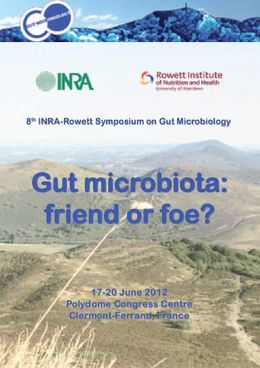- Piacenza
- PRONUTRIGEN Centro ricerca Nutrigenomica e proteomica
- Pubblicazioni Scientifiche
- Abstract e poster a convegni
- Effects of two different high-fat diets on the gut microbiota of adult mice
Effects of two different high-fat diets on the gut microbiota of adult mice

INRA-Rowett Symposium on Gut Microbiology, Gut microbiota: friend or foe?, 17-20 June 2012, Clermont-Ferrand, France
Patrone V, Lizier M, Lucchini F; Minuti A, Trevisi E, Rossi F, Callegari M.L
Abstract
Recently, we reported the short-term changes in the intestinal bacterial community of weaning mice induced by a diet high in unsaturated fat (1).
Here, we investigate the effects of both saturated and unsaturated fat diets on caecal microbiota and physiological features of adult mice over a prolonged period of time.
C57BL/6 mice were fed either a low-fat diet (LFD); a high-fat, soy oil-based diet (HFSD); or a high-fat, coconut oil-based diet (HFCD).
Six mice from each group were killed after 2 (W2) and 8 weeks (W8) of dietary exposure.
Daily weight gain and abdominal fat were determined. Samples of blood for metabolic status assessment, caecum tissue for histological evaluation and caecum content for microbiology analysis by DGGE (2) were collected.
HFSD and HFCD mice showed a higher daily weight gain both at W2 and W8, and an increased abdominal fat as compared to LFD mice (P<0.05).
Blood cholesterol was higher in HFSD (W2) and HFCD (W2 and W8) than in LFD mice (P<0.05).
At W8 the histological analysis of the caecum evidenced that HFSD mice showed an increment of lesions of the mucosa (P≤0.01) and inflammatory cell infiltration (P≤0.05) compared to LFD.
Visual inspection of the DGGE gel showed diet-dependent differences in band intensities: a band of reduced intensity in both HFSD and HFCD mice at W2 and W8 was identified as Lactobacillus gasseri, whereas two bands of increased intensity as compared to LFD mice were related to Clostridium populeti and Gordonibacter pamelaeae upon sequencing.
DGGE data were confirmed by real-time PCR data. Cluster analysis of DGGE fingerprints revealed that HFSD and HFCD mice samples were distinctly grouped from the LFD control mice both at W2 and W8.
These results corroborate previous findings on the impact of dietary fat on the gut microbial ecosystem and the physiology of the host.
- Patrone, V., et al. (2012) Short-term modifications in the distal gut microbiota of weaning mice induced by a high-fat diet. Microbiology 158, 983-992
- Walter, J., et al. (2000) Detection and identification of gastrointestinal Lactobacillus species by using denaturing gradient gel electrophoresis and species-specific PCR primers. Appl. Environ. Microbiol. 66, 297–303
![]() Poster
(754,19 KB)
Poster
(754,19 KB)
PRONUTRIGEN Centro ricerca Nutrigenomica e proteomica
- Chi siamo
- Aree di ricerca
- Servizi e Attività di ricerca industriale
- Pubblicazioni Scientifiche
- Scientific paper in riviste
- Abstract e poster a convegni
- Transcriptomic analysis of the stress response to weaning in the piglets gut
- A transcriptomic analysis of gut response to stress induced by weaning in piglets
- Effects of two different high-fat diets on the gut microbiota of adult mice
- Nutrigenomics: a high fat diet influences gut gene expression in a mouse model
- Piglet adaptation during weaning: some physiological changes and energy metabolism consequences
- Pubblicazioni su riviste con impact factor
- Seminari ed eventi
- Contatti
